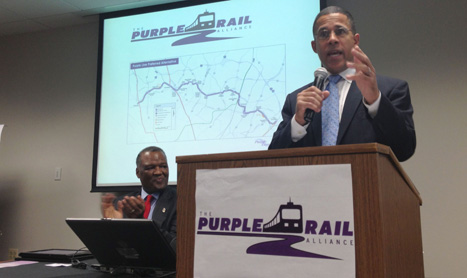GREENBELT — Prince George’s County, state and local officials called for Purple Line funding Thursday, saying the county is ready to make the rail line a reality once it finds a way to pay the hefty price tag.
“In this season of elections and partisan politics let me declare that Maryland is neither a blue state nor a red state. We are a purple state,” said Lt. Gov. Anthony Brown at a news conference at a real estate company in Greenbelt.

(Capital News Service Photo by Chris Leyden)
Plans for the proposed Purple Line include 21 stations for riders traveling between Montgomery and Prince George’s Counties, with transfer points to the Red, Orange and Green lines of the metropolitan Washington Metro rail system. According to Brown, the line would have an estimated 60,000 daily riders, and create 27,000 permanent jobs.
While the project is in the engineering design process, the estimated $1.93 billion funding for it is not there. The state’s Transportation Fund, which is supposed to pay for 50 percent of the project, Brown said, is only at two-thirds the level it was in January 2007. The Maryland Transit Administration’s plan is to have the federal government pay the other 50 percent.
Public-private partnerships could help pay for the project, Brown said, something he added that Virginia and Puerto Rico do very well.
Prince George’s County Executive Rushern Baker said development around the line’s stations would also be crucial, because more revenue from commercial property taxes would stop the county from relying on residential property taxes.
“It’s not going to happen unless we push our federal partners, unless we push the state and, quite honestly, unless we push both business and (the) public sector to really get behind this,” said Baker.
University of Maryland, College Park President Wallace Loh also addressed the crowd of about 70, many of whom wore purple shirts, ties or blouses in support of the project. Loh said the Purple Line was the first issue to come across his desk, and he realized he needed to support the project to keep the university from being “landlocked by impossible traffic conditions.”
“There is no issue that is more important to the future of this university, and of this region, than the Purple Line,” said Loh. The Purple Line would cut right through the heart of campus, connecting New Carrollton and Bethesda.
While many of the movers and shakers of Prince George’s County are behind the project, Henry Kay, executive director for transit development and delivery at the MTA, warned that without the funding all this planning could be for naught.
“The support has to translate into money,” said Kay, who added there is a good enough chance the funding will come through that they can justify planning the project now. He also said the federal government recently helped fund transit projects of a similar size in Charlotte, N.C., and San Francisco.
Although all the speakers at the briefing supported the Purple Line, not every town favors the project.
“We agree we need transit,” said Patricia Burda, mayor of Chevy Chase. However, Burda said the town would prefer a bus rapid transit system. This option would not only protect the Capital Crescent Trail, one of the most used trails in the state, but also have a better chance of actually being built because of the smaller cost, she said.
Andrea Harrison, chairwoman of the Prince George’s County Council, also addressed the room, and channeled her inner President Barack Obama, saying the county is “fired up” about the project and “ready to go.” She also drew a comparison to Portland, Ore., often lauded by experts as one of the best transit systems in the United States.
While there were more than a dozen speakers at the event, hosted by The Purple Rail Alliance, the lieutenant governor may have best summed up the feeling in the room.
“It’s either going to be a very difficult journey ahead,” said Brown, “or an exceedingly difficult journey ahead.”


You must be logged in to post a comment.